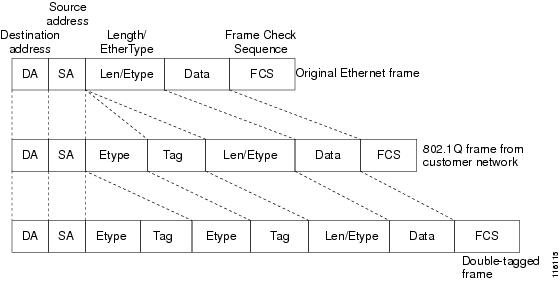
Note |
Only PPPoE is supported on ambiguous subinterfaces. Standard IP routing is not supported on ambiguous subinterfaces.
|
The encapsulation dot1q command is used to configure QinQ termination on a subinterface. The command accepts an outer VLAN ID and one or more inner
VLAN IDs. The outer VLAN ID always has a specific value, and the inner VLAN ID can either be a specific value or a range of
values.
A subinterface that is configured with a single inner VLAN ID is called an unambiguous QinQ subinterface. In the following
example, QinQ traffic with an outer VLAN ID of 101 and an inner VLAN ID of 1001 is mapped to the Gigabit Ethernet 1/1/0.100
subinterface:
Router(config)# interface gigabitethernet1/1/0.100
Router(config-subif)# encapsulation dot1q 101 second-dot1q 1001
A subinterface that is configured with multiple inner VLAN IDs is called an ambiguous QinQ subinterface. By allowing multiple
inner VLAN IDs to be grouped, ambiguous QinQ subinterfaces allow for a smaller configuration, improved memory usage, and better
scalability.
In the following example, QinQ traffic with an outer VLAN ID of 101 and inner VLAN IDs anywhere in the 2001-2100 and 3001-3100
range is mapped to the Gigabit Ethernet 1/1/0.101 subinterface:
Router(config)# interface gigabitethernet1/1/0.101
Router(config-subif)# encapsulation dot1q 101 second-dot1q 2001-2100,3001-3100
Ambiguous subinterfaces can also use the any keyword to specify the inner VLAN ID.
See the Configuration Examples for PPPoE QinQ Support for an example of how VLAN IDs are assigned to subinterfaces, and for a detailed example of how the any keyword is used on ambiguous subinterfaces.

Note |
The any keyword in the second-dot1q keyword is not supported on a subinterface configured for IPoQinQ because IP routing is not supported on ambiguous subinterfaces.
Therefore, multiple values and ranges for the inner VLAN ID are not supported on IPoQinQ.
|




 Feedback
Feedback